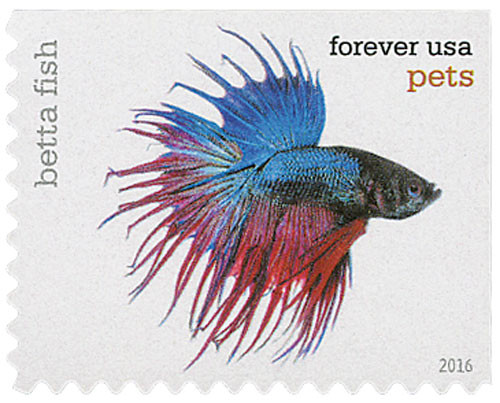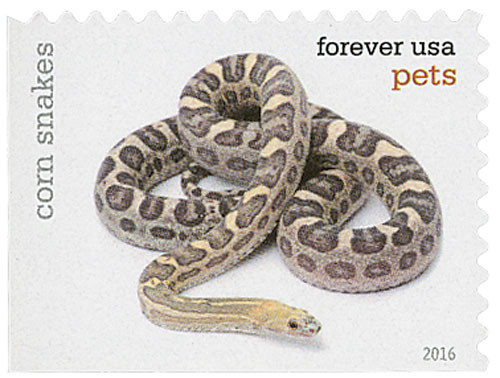
# 5110 - 2016 First-Class Forever Stamp - Pets: Goldfish
US #5110
2016 Goldfish – Pets
- Pictures a goldfish
- Part of the 20-stamp Pets set honoring the wide range of animals we keep as companions
Stamp Category: Commemorative
Set: Pets
Value: 47¢ First Class Mail Rate (Forever)
First Day of Issue: August 2, 2016
First Day City: Las Vegas, Nevada
Quantity Issued: 400,000,000
Printed by: Ashton Potter (USA) Ltd.
Printing Method: Offset
Format: Double-sided Booklet of 20
Tagging: Nonphosphored type III, block tag
Why the stamp was issued: To celebrate the role our pet goldfish play in making our lives more enjoyable.
About the stamp design: Pictures a photograph by Eric Isselée of a goldfish.
First Day City: The First Day of Issue Ceremony was held at the SuperZoo National Show for Pet Retailers at the Mandalay Bay Resort in Las Vegas, Nevada.
About the Pets set: The USPS created 20 stamps to celebrate the many different animals we humans keep as companions. Each stamp pictures one species: puppies, betta fish, iguanas, hamsters, goldfish, kittens, rabbits, tortoises, guinea pigs, parrots, corn snakes, mice, hermit crabs, chinchillas, gerbils, geckos, cats, horses, parakeets, and dogs.
History the stamp represents: Goldfish are the domesticated descendants of chi, East Asia’s wild carp. Long ago, genetic mutations caused some of the usually silver-gray chi to exhibit red, yellow, or orange coloring. This made them more vulnerable to predators. To protect the colorful chi, Buddhist monks began relocating them to ponds during the 9th century. Within a few hundred years, these “goldfish” were living in bowls in people’s homes.
By the 1600s, goldfish were popular pets in Europe. By 1856, P.T. Barnum’s public aquarium claimed to introduce the fish to the United States. But there are hints they might have made their way to North America even earlier. Then, in the 1870s, pet goldfish became an American phenomenon. The US Commission on Fisheries began importing them from Japan to give away as part of a publicity stunt. At one point, they were distributing about 20,000 fish per year. Soon, the colorful aquatic pets were in bowls and private ponds across the country.
Today, goldfish often adorn people’s houses and offices. Inexpensive and easy to care for, they can be as much a part of the décor as they are pets. These exotic swimming ornaments are said to bring joy, relaxation, and maybe – according to Chinese lore – a little luck.
US #5110
2016 Goldfish – Pets
- Pictures a goldfish
- Part of the 20-stamp Pets set honoring the wide range of animals we keep as companions
Stamp Category: Commemorative
Set: Pets
Value: 47¢ First Class Mail Rate (Forever)
First Day of Issue: August 2, 2016
First Day City: Las Vegas, Nevada
Quantity Issued: 400,000,000
Printed by: Ashton Potter (USA) Ltd.
Printing Method: Offset
Format: Double-sided Booklet of 20
Tagging: Nonphosphored type III, block tag
Why the stamp was issued: To celebrate the role our pet goldfish play in making our lives more enjoyable.
About the stamp design: Pictures a photograph by Eric Isselée of a goldfish.
First Day City: The First Day of Issue Ceremony was held at the SuperZoo National Show for Pet Retailers at the Mandalay Bay Resort in Las Vegas, Nevada.
About the Pets set: The USPS created 20 stamps to celebrate the many different animals we humans keep as companions. Each stamp pictures one species: puppies, betta fish, iguanas, hamsters, goldfish, kittens, rabbits, tortoises, guinea pigs, parrots, corn snakes, mice, hermit crabs, chinchillas, gerbils, geckos, cats, horses, parakeets, and dogs.
History the stamp represents: Goldfish are the domesticated descendants of chi, East Asia’s wild carp. Long ago, genetic mutations caused some of the usually silver-gray chi to exhibit red, yellow, or orange coloring. This made them more vulnerable to predators. To protect the colorful chi, Buddhist monks began relocating them to ponds during the 9th century. Within a few hundred years, these “goldfish” were living in bowls in people’s homes.
By the 1600s, goldfish were popular pets in Europe. By 1856, P.T. Barnum’s public aquarium claimed to introduce the fish to the United States. But there are hints they might have made their way to North America even earlier. Then, in the 1870s, pet goldfish became an American phenomenon. The US Commission on Fisheries began importing them from Japan to give away as part of a publicity stunt. At one point, they were distributing about 20,000 fish per year. Soon, the colorful aquatic pets were in bowls and private ponds across the country.
Today, goldfish often adorn people’s houses and offices. Inexpensive and easy to care for, they can be as much a part of the décor as they are pets. These exotic swimming ornaments are said to bring joy, relaxation, and maybe – according to Chinese lore – a little luck.















